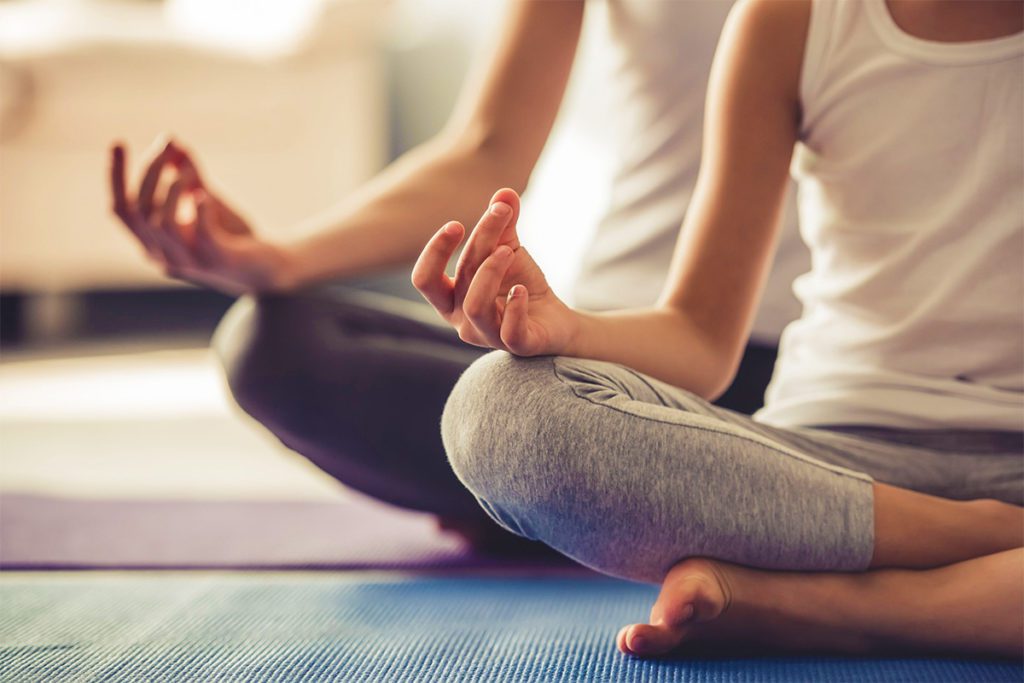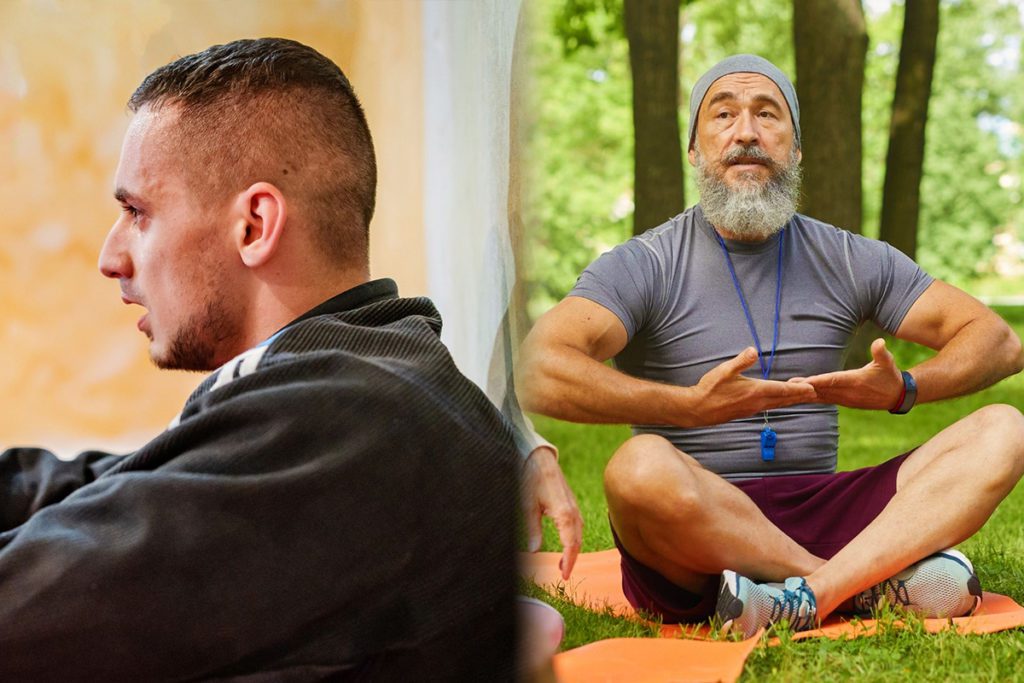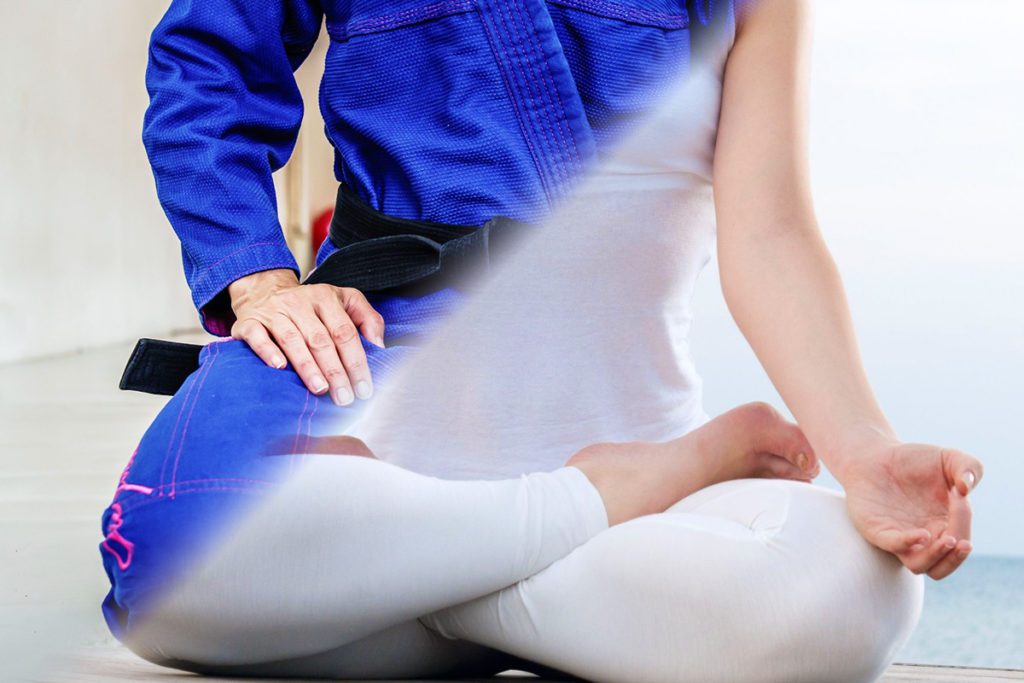What we do off the mats impacts how we perform on them, and it’s common for BJJ practitioners to overlook the importance of supplementary routines and habits outside of normal training. In the long run, staying fit and avoiding injury plays a key part in BJJ development, as it means more time on the mats and a more capable body while upon them.
Yoga in general has gained considerable traction over the past few decades in the western world, and yoga for BJJ specifically has garnered recognition as an intriguing cross-training option. Let’s explore this combination more deeply and see what risks and rewards yoga offers Jiu-Jitsu practitioners.
Is Yoga a Magic Bullet?
Yogis claim that a regular practice can not only offset the common physical issues that stem from consistent BJJ training, but offers other useful benefits such as increased flexibility, breath control, and overall body awareness.
However, like any other physical practice, there are real and serious risks associated with yoga that BJJ enthusiasts should consider before hopping into a hot yoga class. When practiced without proper form or understanding, yoga can create just as many problems as it solves for BJJ players.
Once you understand yoga’s origins and aims, the benefits become readily apparent and accessible, and the common pitfalls easy enough to avoid.
An Incredibly Condensed Backstory
While yoga’s origins can be traced back thousands of years, the majority of the physical poses we think of as yoga in the west weren’t adopted until the 15th century, and centered around seated meditation. From the 19th century onward the number of poses increased dramatically, resulting in the hundreds of variations floating around yoga studios and social media feeds today.
Interesting to note here is the parallel with BJJ’s development, which too can claim ancient roots tied to Japanese martial arts that stretch back centuries, but whose modern incarnation as we know it only came to be around the turn of the 20th century.
In the modern era, yoga has spread like wildfire from the East to the West, becoming a multi-billion dollar industry with over 300 million practitioners.
Although yoga as we know it would unlikely be recognized by whomever you credit with its founding (strong cases can be made for the guru Patanjali, or perhaps the four-armed god of destruction Shiva – who BJJ practitioners would do well to befriend anyway – and many others), it still retains its original aim of satiating the body’s desire for movement, restoring a sense of balance, which afterward allows the mind to settle into stillness.

The Real Risks of Yoga
As with any physical activity that incorporates dynamic movements, there are some legitimate risks of injury when it comes to yoga for BJJ practice.
It’s helpful to divide the two types of injuries – immediate and long-term injury. Those considering yoga for BJJ should keep each in mind when practicing, as they require different kinds of awareness to recognize and avoid.
Risks of Immediate Injury in Yoga
We all know and fear immediate and soul-crushing injuries that will keep us off the mats for weeks and months at a time. Torn ligaments, dislocated or broken bones, basically anything that we can’t in good faith just put tape on, ignore, and hope it will heal in time.
The most common immediate yoga injuries occur when muscles are stretched past their natural limits. Nerves will send the brain ample warning in the form of sharp stinging pain when something is grossly misaligned and unsafe to hold, but it’s up to the practitioner to heed this warning and back off.
Some of the most commonly injured areas are the wrists, shoulders, and neck. When doing a standard vinyasa flow, you will likely come through the chaturanga sequence several times. This sequence can work wonders to warm up and tone the whole body, but it’s also the main culprit behind many yoga-related injuries.
While it’s easy to assume that the chaturanga is the same as a western push-up, the position is notably different. The elbows should stay glued to the ribs, thus making it more of a whole-body movement that incorporates the chest and abs rather than dumping into the poor shoulders.

Unlike the deep sockets of the hip joint complex, the shoulder joint simply wasn’t designed to bear the weight of our whole body for long periods of time. Similarly, the tiny disc bones of the cervical spine were designed to hold and turn our lovely heads, and asking them to hold the entire body as well can be problematic.
Neck-centric yoga poses are an especially dangerous place to be for BJJ players, who regularly have their necks cranked or choked in training, compromising their overall integrity to some degree. An ill-timed or misaligned yoga pose could aggravate existing damage, leading to a more serious injury.
How to Avoid Immediate Injuries in Yoga
One way to offset these inherent risks is to ensure your point of contact with the ground is wide with your weight evenly distributed.
In the case of the hands, this means the four corners of the palm are your contact points – the same concept applies to the four corners of the foot. In either case, the chest, back, legs, and abs often serve as vital support that shares the burden of the body’s weight, ideally never leaving one area entirely alone in supporting the body.

For instance, in poses like shoulder stand, a strong and active core and back can alleviate some of the pressure that can potentially damage the neck. Avoid locking out the joints or dumping your entire weight into any one of them as well, as this puts a dangerous amount of pressure on tendons.
Time of day plays a role as well, we typically are far tighter in the morning when compared to the evening after a day of natural movements – in cold winter especially so.
Yoga positions should be able to be held safely and comfortably. Now, of course, there will be challenging moments of balance, cardio, and general unease in the strange and compromising positions, but this is far different than sharp pain which precedes injury.
With yoga, the best way to avoid injury is to follow the instructor’s guidance, know your individual limits and needs, and listen to your body’s natural signals. Unfortunately, however, there is still potential for injury in a less obvious way.
Risks of Long-term Injury in Yoga
Now, these types of injuries are the more nefarious types, as you won’t have the stinging sensation alarm to necessarily warn you as with immediate injuries.
Serious injuries can occur if you practice the poses incorrectly and wear down joints over time. It might take years, but even small details can erode away connective tissue until one day, it gives.
A Simple Recipe for Avoiding Long-Term Injury in Yoga
The best way to counteract these sneaky issues is by practicing with a well-trained teacher, especially when you first begin. Studios and personal teachers are a wonderful tool for this as they can spot and correct an imbalance instantly, whereas recorded videos or solo practice lack this critical live feedback element.
Just as we don’t recommend tossing new white belts in the vicious ocean of an open mat, new yogis should learn core movements and principles before being tossed to the proverbial sharks of an unguided sequence and advanced poses.
As with BJJ, a strong understanding and repetition of the fundamentals have proven time and time again to be a safe and proven path that leads to success – whatever that means to your practice.
What looks appealing and perhaps even attainable on the internet likely took years for the practitioner to build up to, and if nothing else, yoga is a lesson in personal patience. Take your time, play the long game, and you will reap the rich rewards eventually.
The Rich Rewards
The benefits of a proper yoga practice are plentiful and can make you an especially annoying opponent to face on the mats. Practitioners can notice a difference in their body’s ability after only a few weeks of consistent practice, and better yet, these benefits will only ripen and deepen with time and practice.
Injury Prevention and Recovery
The best way to deal with injuries is to prevent them from occurring. While some wear and tear is inevitable, more lubricated joints and flexible muscles mean those who practice yoga for BJJ will have slightly more leeway in their capacity to stretch – and in the context of BJJ – be stretched against their will before it becomes unbearable.
This does not mean that you will have magic submission defense ability, more likely a slightly larger window of movement that could be used to escape. Once a submission hold is secured, no yoga technique will teleport your neck and joints out from danger.
Injuries happen in life, whether as a direct result of BJJ, an accident, or just good old fashion aging. Restorative yoga is a specialized form that can be both effective rehab for a wide variety of injuries, and also offers a way to keep the body engaged and active until it is ready for the mats again.
Better Body and Spatial Awareness
Yoga invariably leads to a deeper understanding of your own body. In time, you’ll understand precisely how long your limbs are, what muscles of yours tend to be tighter and looser, and perhaps most important as it relates to BJJ – how they move through space.
Raising your body’s innate understanding of its location, action and movement is called proprioception. It’s a subtle understanding of knowing where everything is on your body without seeing it, and yoga helps practitioners develop this sense through hours of practice. Consider it a refined internal gauging system as to where everything is and how it’s feeling, useful metrics in any activity.
This kind of spatial awareness is especially useful when dealing with a hostile human body. Rarely in BJJ do we have a clear view of our opponent’s whole body once we hit the ground, and factors like sweat, flailing limbs and fabrics again reduce our sight’s ability to relay critical information about the position of both our body and our opponents.
Increased Flexibility and Balance
Increased flexibility is what’s written on the label for most yoga studios, and is perhaps the most flaunted benefit of practice. We need not stay long here, because even detractors of yoga agree that it will increase flexibility (infact, some claim it overextends muscles so they lose elasticity, a valid concern, but avoidable if you expand your limits incrementally).
Balance is the distribution of weight, and yoga will certainly build a familiarity with the concept as challenging flow sequences often call for one-legged poses that necessitate a strong base and balance.
For BJJ, these same principles can make it more difficult for you to be taken down and give you a more intuitive feel for sweeps which typically rely on a shift of balance between combatants. Even a small improvement in these areas can be just the edge you need in a close match.
Control of Breath
Where the breath goes, the body and mind follow, and this yogic skillset can be used in all sorts of beneficial ways for BJJ players.
We all know and love the white belts who spazz frantically and practically foam at the mouth, gassing out the first minute of a five-minute round. One of the core concepts BJJ practitioners intuitively learn is to calm down during a roll, letting the conscious mind make some decisions while the body battles.
In yoga, we move with the breath, expanding with an inhale, and contracting on an exhale. Keeping our breath controlled and moving through the nose is seen as ideal during both BJJ and yoga, but as we all know, this sometimes falls to the wayside in the face of sweaty adversity.
However, having a system to fall back on and refer to is helpful, and when used properly, it provides the body a steady supply of oxygen and the mind a bit of clarity.

Effective Warm-up and Cooldown
While running in small circles, doing high knees, and cartwheeling across mats delights everyone’s inner child, yoga sequences can be used as an effective warm-up to BJJ class.
Notably, I would say fundamental drills like shrimping, front and back rolls, and the like cannot be replaced by yoga, even if some of the same muscle groups are activated. Though at times monotonous, these build essential muscle memory for BJJ players.
Cooldowns for the most part in BJJ classes are non-existent. Typically after the rolling portion of class concludes, students line up for the ceremonial bow and handshake, and then we limp along our merry way home. By the time we’re showered and fed, most prefer to enter a well-deserved catatonic semi-mummified state.
However, this is the opportune time for some low-impact restorative yoga poses to take the edge off recovery time. Studies show that stretching after a strenuous activity like BJJ can curb some of the deep tissue soreness, shortening recovery time, and allowing you to return the mats with full power and glory.
Mental Benefits
Most yoga classes close with Savasana, also known as corpse pose, where you lay on your back without tension and are simply left alone with your body, breath, and thoughts for a few minutes. Though not physically challenging, it can be quite difficult to not mentally drift away in this time to all manner of thoughts that come knocking.
This portion of class can be seen as a trial run or gateway to classic meditation, an activity that almost all major athletic disciplines, the scientific community, and other institutions of critical thought agree offers benefits to someone attempting to do something complex or difficult.
Let’s take a moment to note how rare it is to get consensus on anything these days, and even those who wave off yoga practice as a whole would be hard-pressed to do so with meditation.
If nothing else, taking a little time to collect yourself mentally before getting on the mats improves focus and memory retention. Afterward, it can offer an opportunity to reflect on the lessons and lower that heart rate a tad before we shed our gis and attempt to reenter conventional society.

Why It Matters
At their core, BJJ and yoga are more related than one might initially assume. Both disciplines incorporate subtle movements, explore the mind-body connection, and promote patience and commitment to the long path of personal improvement.
Even if done begrudgingly and in small doses, yoga for BJJ will help with basic alignment principles and understanding of body mechanics. Over time yoga can become an entirely new skill set in itself, a fun activity in contrast to BJJ as there are no points to score or battle to win.
When blended together properly, they make for a uniquely balanced individual, one as well-equipped and equally prepared for the rigors of BJJ battle as they are for the quiet introspection of yoga.

“Brian O’Dea is a blue belt in BJJ and yoga teacher who enjoys using his extra bendiness to annoy opponents.
He believes in the sanctity of pressure passing and that eating dark chocolate with crunchy peanut butter is a peak human experience.

